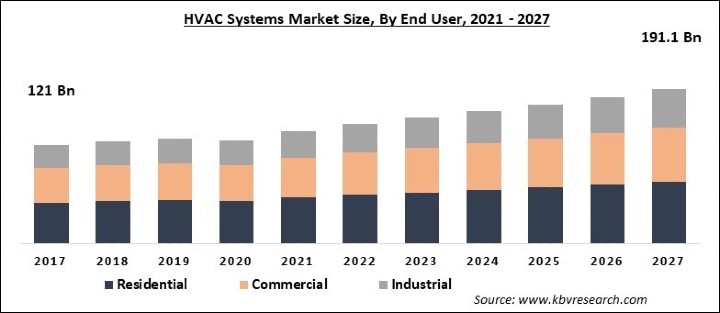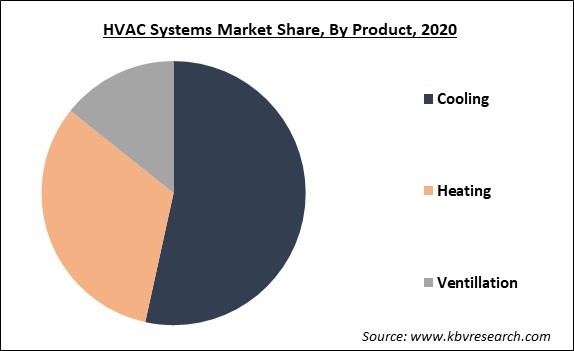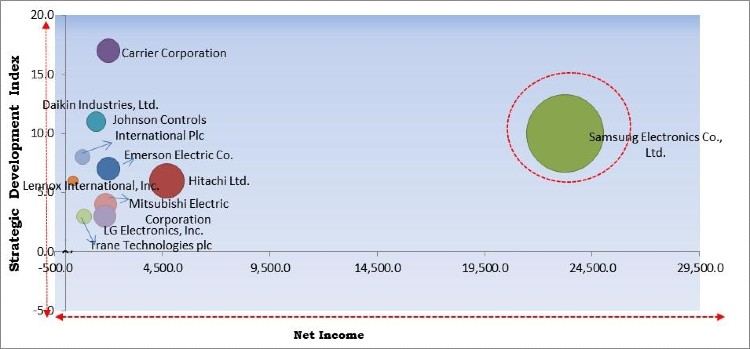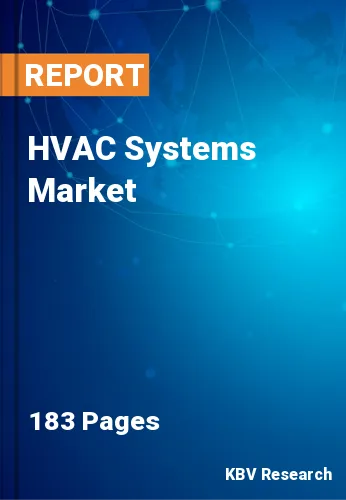The Global HVAC Systems Market size is expected to reach $191.1 billion by 2027, rising at a market growth of 5.5% CAGR during the forecast period. The HVAC systems are capable of offering cooling and heating to commercial as well as residential buildings. HVAC systems are located anywhere from single-family homes to submarines where they offer the measures for maintaining a healthy environment. These systems utilize fresh air from the outdoors to offer high indoor air quality, thereby gaining huge traction in new construction.
The V in HVAC, or ventilation, refers to the process of substituting or exchanging the air inside a space. This offers a superior quality of air indoors and includes the removal of moisture, heat, smoke, odors, dust, carbon dioxide, airborne bacteria, and other gases and temperature control & oxygen replenishment.
The demand for HVAC (Heating, ventilation, and air conditioning) is boosted by the emergence of unique & technically sophisticated products which are energy-efficient and can be accessed remotely. The growth of the global HVAC systems market is expected to be boosted by the utilization of natural refrigerants, like CO2, along with growing efforts by several governments around the world with an aim to support energy-efficient products. Moreover, the growth of the HVAC systems would be boosted by the paradigm shift towards the acceptance of energy-efficient air conditioners that can decrease costs and power wastage.

The outbreak of the global COVID-19 pandemic has created a devastating impact on the worldwide economy since the onset. In the first quarter of 2020, the growth of the global heating, ventilation, and cooling system market has witnessed a slowdown due to the outbreak of the COVID-19 pandemic. This is due to the stringent lockdown restrictions of various component manufacturing units across the countries like the U.S., Germany, Ireland, China, and others. The strict lockdown measures had slowed down the manufacturing process but also decreased the customer demand for these devices.
Though, the demand for HVAC systems is directly proportional to air fillers across residential utilization, purified air supply across commercial buildings, and the reduction of suffocated air over industrial areas. In addition, various government bodies like the Federation of European Heating, Ventilation and Air Conditioning Association, ASHRAE, and others are installing mitigation tactics that would be helpful in decreasing the chances of this system becoming contaminated with the COVID-19 virus. This, as a result, would create new growth avenues for the growth & demand for these systems throughout the present pandemic.
The United States Environmental Protection Agency states that indoor air quality is approximately two to five times worse in comparison to outdoor air, majorly since there is a congestion of the airflow. This polluted air inside the home can cause colds to stay for a longer period and allergies to be more serious. An HVAC system can enhance air quality by consistently exchanging the indoor air with outdoor, fresh air that is also filtered for the best quality possible.
The growth of the global HVAC market is driven by the surge in demand for technologically sophisticated heating, ventilation, and cooling systems. The development in green-labeled products because of the rising environmental awareness has resulted in thermally driven air-conditioners. Makers like Lennox International Inc., Daikin Industries, Ltd., and others are providing these systems. These air-conditioners use both natural gas and solar energy, hence conforming to energy efficiency.
The growth of the market is expected to be hindered by the low availability of efficient technicians for HVAC systems. As per the Bureau of Labor Statistics, the U.S. has a low availability of above 70,000 technicians. Also, the companies are expected to witness approximately 115,000 new heating, ventilation, cooling, and refrigeration qualified technicians in the upcoming years.
Based on Product, the market is segmented into Cooling, Heating and Ventilation. Heating units like heat pumps, boilers, and furnaces, are extensively utilized in commercial, residential, and industrial applications. Space heating, steam generation, molding, vaporization, floor & wall heating, and drying are some of the major applications of heating equipment. Therefore, the growth of this segment is expected to be boosted by those regions that have excessive cold climatic conditions and industries that need a heating process.

Based on End User, the market is segmented into Residential, Commercial, and Industrial. The residential segment procured the highest revenue share of the HVAC Systems market in 2020. In addition, residential HVAC units are compact and have a simple installation in comparison to commercial or industrial units. The residential segment consists of equipment utilized in small spaces, like stores & restaurants, and houses.
| Report Attribute | Details |
|---|---|
| Market size value in 2020 | USD 126.9 Billion |
| Market size forecast in 2027 | USD 191.1 Billion |
| Base Year | 2020 |
| Historical Period | 2017 to 2019 |
| Forecast Period | 2021 to 2027 |
| Revenue Growth Rate | CAGR of 5.5% from 2021 to 2027 |
| Number of Pages | 183 |
| Number of Tables | 263 |
| Report coverage | Market Trends, Revenue Estimation and Forecast, Segmentation Analysis, Regional and Country Breakdown, Competitive Landscape, Companies Strategic Developments, Company Profiling |
| Segments covered | Product, End User, Region |
| Country scope | US, Canada, Mexico, Germany, UK, France, Russia, Spain, Italy, China, Japan, India, South Korea, Singapore, Malaysia, Brazil, Argentina, UAE, Saudi Arabia, South Africa, Nigeria |
| Growth Drivers |
|
| Restraints |
|
Based on Regions, the market is segmented into North America, Europe, Asia Pacific, and Latin America, Middle East & Africa. North America was the second-largest region in the HVAC systems market in 2020. Moreover, the region would showcase a moderate growth rate during the forecast period. The European market would display a promising growth rate, boosted by the thriving tourism industry and real estate industry in the region. Governments of various countries in both regions are encouraging the usage of energy-efficient systems by offering subsidies and tax advantages. Due to this, current customers are also updating new energy-efficient systems along with the new constructions.

Free Valuable Insights: Global HVAC Systems Market size to reach USD 191.1 Billion by 2027
The major strategies followed by the market participants are Product Launches. Based on the Analysis presented in the Cardinal matrix; Samsung Electronics Co, Ltd. are the forerunners in the HVAC Systems Market. Companies such as Carrier Corporation, Johnson Controls International Plc, and Hitachi Ltd. are some of the key innovators in the market.
The market research report covers the analysis of key stake holders of the market. Key companies profiled in the report include Carrier Global Corporation, Johnson Controls International PLC, Hitachi, Ltd., Emerson Electric Co., Mitsubishi Electric Corporation, Trane Technologies PLC, Samsung Electronics Co., Ltd., Daikin Industries, Ltd., LG Electronics, Inc. and Lennox International, Inc.
By Product
By End User
By Geography
The HVAC systems market size is projected to reach USD 191.1 billion by 2027.
HVAC systems offer superior Indoor Air Quality and help in energy conservation are driving the market in coming years, however, Low availability of efficient labor limited the growth of the market.
Carrier Global Corporation, Johnson Controls International PLC, Hitachi, Ltd., Emerson Electric Co., Mitsubishi Electric Corporation, Trane Technologies PLC, Samsung Electronics Co., Ltd., Daikin Industries, Ltd., LG Electronics, Inc. and Lennox International, Inc.
The cooling product segment acquired the maximum revenue share of the HVAC systems market in 2020 and would showcase a similar kind of trend even during the forecast period.
The commercial segment would witness the fastest growth rate during the forecast period.
Asia-Pacific emerged as the largest region of the global HVAC systems market in 2020.
Our team of dedicated experts can provide you with attractive expansion opportunities for your business.

